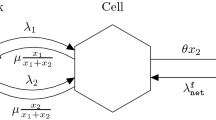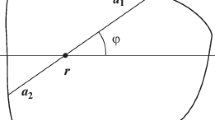Abstract
This paper presents the study of the hyper-Erlang distribution model and its applications in wireless networks and mobile computing systems. We demonstrate that the hyper-Erlang model provides a very general model for users' mobility and may provide a viable approximation to fat-tailed distribution which leads to the self-similar traffic. The significant difference from the traditional approach in the self-similarity study is that we want to provide an approximation model which preserves the Markovian property of the resulting queueing systems. We also illustrate that the hyper-Erlang distribution is a natural model for the characterization of the systems with mixed types of traffics. As an application, we apply the hyper-Erlang distribution to model the cell residence time (for users' mobility) and demonstrate the effect on channel holding time. This research may open a new avenue for traffic modeling and performance evaluation for future wireless networks and mobile computing systems, over which multiple types of services (voice, data or multimedia) will be supported.
Similar content being viewed by others
References
F. Barcelo and J. Jordan, Channel holding time distribution in cellular telephony, in: The 9th International Conference on Wireless Communications (Wireless'97), Vol. 1, Alberta, Canada (9–11 July 1997) pp. 125-134.
V.A. Bolotin, Modeling call holding time distributions for CCS network design and performance analysis, IEEE Journal on Selected Areas in Communications 12(3) (1994) 433-438.
E. Chlebus and W. Ludwin, Is handoff traffic really Poissonian?, in: IEEE ICUPC'95, Tokyo, Japan (6–10 November 1995) pp. 348-353.
D.C. Cox, Wireless personal communications: what is it?, IEEE Personal Communications Magazine (April 1995) 20-35.
E. Del Re, R. Fantacci and G. Giambene, Handover and dynamic channel allocation techniques in mobile cellular networks, IEEE Transactions on Vehicular Technology 44(2) (1995) 229-237.
Y. Fang and I. Chlamtac, Teletraffic analysis and mobility modeling for PCS networks, IEEE Transactions on Communications 47(7) (July 1999) 1062-1072.
Y. Fang and I. Chlamtac, A new mobility model and its application in the channel holding time characterization in PCS networks, in: Proceedings of INFOCOM'99, New York, NY (March 1999).
Y. Fang, I. Chlamtac and Y.B. Lin, Channel occupancy times and handoff rate for mobile computing and PCS networks, IEEE Transactions on Computers (June 1998).
Y. Fang, I. Chlamtac and Y.B. Lin, Modeling PCS networks under general call holding times and cell residence time distributions, IEEE Transactions on Networking 5(6) (December 1997) 893-906.
Y. Fang, I. Chlamtac and Y.B. Lin, Call performance for a PCS network, IEEE Journal on Selected Areas in Communications 15(8) (October 1997) 1568-1581.
A. Feldmann, A.C. Gilbert and W. Willinger, Data networks as cascades: investigating the multifractal nature of Internet WAN traffic, in: Proceedings of the ACM/SIGCOMM'98, Vancouver, Canada (September 2–4, 1998).
G.J. Foschini, B. Gopinath and Z. Miljanic, Channel cost of mobility, IEEE Transactions on Vehicular Technology 42(4) (1993) 414-424.
R.A. Guerin, Channel occupancy time distribution in a cellular radio system, IEEE Transactions on Vehicular Technology 35(3) (1987) 89-99.
D. Hong and S.S. Rappaport, Traffic model and performance analysis for cellular mobile radio telephone systems with prioritized and non-prioritized handoff procedures, IEEE Transactions on Vehicular Technology 35(3) (1986) 77-92.
C. Jedrzycki and V.C.M. Leung, Probability distribution of channel holding time in cellular telephony systems, in: IEEE Vehicular Technology Conference (VTC'96) (1996) pp. 247-251.
J. Jordan and F. Barcelo, Statistical modelling of channel occupancy in trunked PAMR systems, in: The 15th International Teletraffic Conference (ITC'15), eds. V. Ramaswami and P.E. Wirth (Elsevier, 1997) pp. 1169-1178.
F.P. Kelly, Reversibility and Stochastic Networks (Wiley, New York, 1979).
L. Kleinrock, Queueing Systems: Theory, Vol. I (Wiley, New York, 1975).
W.E. Leland, M.S. Taqqu, W. Willinger and D.V. Wilson, On the self-similar nature of Ethernet traffic (extended version), IEEE/ACM Transactions on Networking 2 (1994) 1-15.
W.R. LePage, Complex Variables and the Laplace Transform for Engineers (Dover, New York, 1980).
Y.B. Lin, S. Mohan and A. Noerpel, Queueing priority channel assignment strategies for handoff and initial access for a PCS network, IEEE Transactions on Vehicular Technology 43(3) (1994) 704-712.
A.R. Noerpel, Y.B. Lin and H. Sherry, PACS: Personal access communications system-a tutorial, IEEE Personal Communications 3(3) (June 1996) 32-43.
P.V. Orlik and S.S. Rappaport, Traffic performance and mobility modeling of cellular communications with mixed platforms and highly variable mobilities, Proceedings of the IEEE (1998) (to appear).
P.V. Orlik and S.S. Rappaport, A model for teletraffic performance and channel holding time characterization in wireless cellular communication with general session and dwell time distributions, IEEE Journal on Selected Areas in Communications 16(5) (1998) 788-803.
W. Stallings, High-Speed Networks: TCP/IP and ATM Design Principles (Prentice-Hall, 1998).
W. Willinger, M. Taqqu, R. Sherman and D. Wilson, Self-similarity through high-variability: statistical analysis of Ethernet traffic at the source level, in: Proc. ACM SIGCOMM'95 (1995) pp. 100-113.
Author information
Authors and Affiliations
Rights and permissions
About this article
Cite this article
Fang, Y. Hyper-Erlang Distribution Model and its Application in Wireless Mobile Networks. Wireless Networks 7, 211–219 (2001). https://doi.org/10.1023/A:1016617904269
Issue Date:
DOI: https://doi.org/10.1023/A:1016617904269




